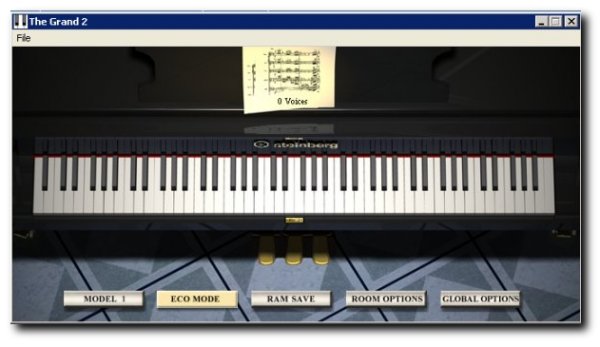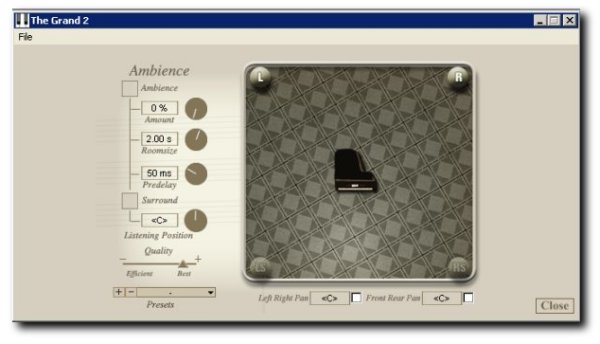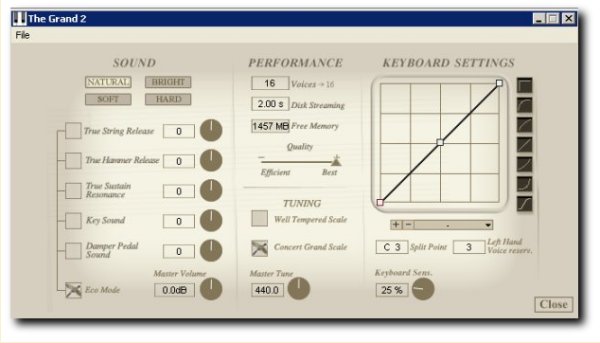Steinberg The Grand 2

In the overcrowded realm of digital pianos where you find the best and the worst, The Grand 2 appears as one of the most recent achievements in acoustic instrument simulations.
If the first version of the program suffered from a few youth flaws, the experience aquired by Steinberg paid off and their programmers have now established their pedigree.
Not only does The Grand 2 have a very simple GUI but it is also very flexible and thus can adapt itself to any music style and playing style, ranging from classical to jazz, live or in the studio. This quality is very important, because, although lots of digital pianos sound great and realistic when played in solo, they have difficulties to fit in in an orchestral context, be it acoustically or digitally. And we're not even talking about recording a singer accompanied on this type of instrument - a problem that we encounter in opera singing, most of the time.

Playing realism
When dealing with realism, three conditions are to be considered and met :
a) Realism when recording songs (the general quality of sound).
b) Realism when listening to the piano, from where the listener is located, in front of the player.
c) Realism when playing the piano in realtime (the sensations felt by the player).
If the first condition is met by The Grand 2, carefulness makes us think that it will take some time before any digital piano can sound like a real acoustic piano, live in concert. But, again, the day we'll be able to prompt acoustic sensations - from the listener's point of view, in front of the digital piano -, we'll still be far from achieving the same sensations from the player's point of view. Indeed, in the current state of technology, 100-% playing realism is impossible to achieve with a piano outputting its sound through a pair of loudspeakers. The monitoring system must allow very high output power (even if you don't use it at maximum) to be able to produce all these instantaneous variations going over the nominal level by more than tens of decibels. Here, we are closer to high fidelity. The sensations that we feel when playing a real acoustic piano, where the sound comes from the sounding board, cannot be reproduced - at the moment - by the electronic components found in a pair of loudspeakers. Realism is not dependent on the piece of software only, but on the whole acoustic system, amplifier, cabinets, placement of the instrument and acoustics of the room.
As I work mostly in the studio, I am ready to give up an important part of playing realism, if the program gives me more listening realism. Nevertheless, playing realism allows me to feel richer sensations which stimulate my imagination and boost my improvisation capacities.
With The Grand 2, DAW users can now count on a tool sounding more real than real when recording, providing of course that they know how to set-up the program and can deal with sound techniques, because The Grand 2 is a precision tool requiring adapted handling. Nevertheless, live-playing musicians will be satisfied too with the quality of sound, the simplicity of the GUI and, above all, the quality of The Grand 2 when it is mixed with a whole band.
Although the Grand 2's ease-of-use can satisfy the hobbyist who only starts his/her computer and starts playing, the more demanding musician will want to extract all the musical richness that the program is capable of, providing he owns sharp ears and knowledge.
Overall sound
The first impression with The Grand 2 is sturdy low-ends, penetrating high-ends and cristal-clear mid-frequencies. Straight away, the personality of the instrument is absolutely characteristic and allows us to classify it among usual piano sounds.
In the world of acoustic pianos, there are three main sound types :
a) Mellow or muffled sounds peculiar to study pianos, which are still very interesting musically, nevertheless.
b) Biting or "masculine" sounds, like Steinway, Yamaha, Kamai, etc.
c) "Clean" and flawless sounds, like Bösendorfer, Pleyel, Petroff, Grotrian, etc.
The Grand 2 will please those who prefer the last type of sound. It is most prominent when playing the two central octaves, between C3 and C5 (small octave and 1st octave according to the Rimski-Korsakov classification).
Nevertheless, considering the amount of people who are keen on the Steinway-type "masculine" sound, we hope Steinberg developers will think about implementing it in a future version.
Beware of not being fooled by the apparent simplicity of the GUI. The few buttons available can deeply modify the sound and inflence lots of parameters, providing the user has enough ear-sharpness to detect all setting-subtleties and their influence on sound, as well as the differences there are between a solo context and an orchestral context. Users should not hesitate to spend a lot of time modifying settings in order to find the right sound and then save any satisfactory setting. We just wish there had been factory presets available, programmed by experts, because it would make things easier for musicians who don't want to make life difficult for themselves with actions closer to those of an engineer's than a musician's. About this, we are waiting for users' contributions.
"Extramusical" sounds
The Grand 2 features the "extramusical" sounds that bring not only more realism to recordings, but also the attraction of acoustic instruments' little flaws : mechanical noises ; noise of the hammer beating the strings (which is an integral part of the sound of a piano when playing higher notes, even if you listen to it when you're not next to it) ; noise of the dampers leaving the strings and resting on them when you press the right pedal ; as well as the resonance of the whole harp when the strings are ringing freely. These "crop" noises have to be set-up as sharply as all the other sounds.
Pertaining these "crop" sounds, we can notice the three following things :
a) The sympathetic resonance of acoustic pianos is not featured by The Grand 2. This kind of resonance can be highlighted by the following experimentation : C, E and G keys are pressed with minimal velocity so that the dampers leave the strings without them being struck by the hammers. When playing a strong and detached low C, the strings that were previously released start to ring. To my thinking, there is currently no piano simulation featuring this kind of characteristic. Yet, this effect is used by some contempory music composers, and even by some impressionist composers (Charles Ives).
b) The sound of the whole set of dampers striking the strings when you release the right pedal is, in my opinion, erroneous and has to be corrected. It sounds as if a metallic object was lightly brushing against the strings, whereas in real life this sound is a dull, heavy and muffled sound. It is nevertheless well simulated for notes played individually, when you release a key and the damper falls back down onto the string.
c) The intensity of the resonance and the quality of the sustain (CC 64 or CC 146) could be unsatisfactory when playing intense and very fast passages with the pedal pushed down. There is currently no digital piano that can compete with an acoustic piano for this kind of passage. In this case, do not hesitate to set-up the controler at its maximum value and deepen the effect by using a convolution reverb that you'll control with the sustain pedal (setup as "all or nothing"), via Cubase's Generic Remote.
Pedals
On grand pianos, the left pedal shifts the whole mechanism so that the hammers hit only one string at a time. On upright pianos, the left pedal puts the hammers closer to the strings so that their stroke is shortened and, therefore, the key strikes are less powerful. The result is different but satisfactory because the role of the left pedal is to reduce dynamics without losing expressiveness. Playing "normally" without using the left pedal allows a great dynamic range, depending on the velocity levels that the pianist is capable of. Without the left pedal, the musician who wants to play "pianissimo" has to hold back his touch, and it reduces his expressive range, whereas the left pedal gives a softer sound without losing playing subtleties. One should notice that the left pedal softens "masculine" piano sounds. In the case of The Grand 2, this effect is very effective, because the softness of the tone is already present in the very nature of the instrument.
This pedal allows the player to hold the notes that he has already played without the need to hold the keys down. It allows, for instance, to play a low-octave note with the left hand, let it ring and carry on playing detached notes with both hands on the higher octaves of the keyboard. This pedal acts as a third hand which carries on holding notes in a part of the keyboard that isn't accessible anymore. This feature is not widely-known. Lots of pianists who have worked on upright pianos have never practiced using this pedal, yet its qualities are interesting not only in classical music but also in other styles where the piano has an important role.
The GUI
It offers three independent windows.

This window displays a virtual piano with a keyboard on which you can play with your mouse or push the pedals. This feature is interesting because it allows you to check that The Grand 2 is connected to the soundcard's outputs without having to use your MIDI interface. Except the little gadget function allowing you to open/close the lid of the piano by clicking on the lock, the score drawn on the piano is in fact a digital field displaying the number of voices used by the program. At the bottom of the window, five buttons are available of which the first three give access to three extra functions.
Model 1 or 2 : this button allows you to choose one of the two available piano models. The difference between them is significant although it is not obvious. It is most noticeable when you open two instances of The Grand 2 in order to have the two models play in parallel. In this situation, the sound is greatly improved.
Eco Mode : this buttons allows you to save ressources, when the best sound quality is not needed.
RAMsave : this option scans the MIDI notes used in a song and unloads any samples on notes not being played in the sequence in order to free some memory.
Room Options : this button opens the "Room" window.
Global Options : opens the associated window.

In this window you can access reverberation and placement parameters : Amount, Roomsize and Predelay. A tickbox allows you to activate the two rear channels of a surround system. A fader adjusts the quality of the reverb and two tickboxes below the drawing of the room (with the placement of the piano inside it) allow you to lock/unlock the horizontal movement while moving the piano vertically and vice-versa. You also have access to a few presets where you may save your own ones if you want to.
The functions available in this window add a lot of recording and listening realism. The reverb is not bad, but there's no doubt that the more demanding musician will prefer to use his/her own reverbs and settings.

Here, you can set the general parameters of the instrument. The window offers three sections : Sound, Performance and Keyboard Settings. Using it is child's play. Five tickboxes with a knob give access to "crop" noises settings.
In the Sound section, we get the following parameters :
True String Release : the modified sound of the strings when the damper touches them to stop the note from ringing.
True Hammer Release : the noise made by the hammer when it goes back to its rest position.
True Sustain Resonance : the sound of the strings when they ring freely (which is normally a sympathetic resonance).
Key Sound : the non-musical noise of the hammer when it strikes a string. This noise is the one that gives most realism to the sound, particularly on the high notes.
Damper Pedal Sound : the sound of the whole set of dampers when they leave the strings and fall back on them when you release the sustain pedal. As we said above, in the version we own the sound of the dampers leaving the strings is good, but not the sound of their falling back.
Eco Mode gives you the possibility to activate/deactivate all the above functions in one go.
On the right, there is a Master Volume knob. No need to explain.
The centre section, Performance, sets the computer ressources used by the program. The first available field sets the number of voices used by The Grand 2. For optimum playing comfort, the recommanded setting is 120 voices, as long as your computer can support it. A second field, Disk Streaming, sets the amount (duration) of sound that is loaded into your RAM before the system starts reading the rest of the sample onto your hard disk drive. A third - unmodifiable - field displays the amount of available RAM.
The other settings available in the Keyboard Settings section are obvious and they don't need explanation. The velocity and sensitivity settings are useful for those who don't own a programmable master keyboard. Yet, one field needs some little explanation : Left Hand Reserve. It allows you to give priority to the notes played by your left hand so that they won't be cut up if you exceed the available number of voices with your right hand. If you hear that some notes on the left of the split-point are cut up, increase this setting.
As a conclusion
Although The Grand 2 is, in my opinion, one of the most advanced digital pianos available, there's no question of playing Tchaïkovski's, Liszt's or Rachmaninov's works, or works requiring huge amounts of voices or sounds prompted by what I am used to calling "bangingly chaos". This sensation of sound tsunami produced by the thunderous power required by certain passages of romantic music works. Until now, nothing can replace a good acoustic piano for this kind of passages. A good quality acoustic piano always gives the impression of a limitless physical power in what it can take and what it can output. Digital pianos still have a long way to go to be able to compete with a real acoustic piano. Nevertheless, The Grand 2 will perfectly satisfy classical pianists who are keen on baroque, classical (such as Mozart) or romantic styles (such as Schubert or even Chopin, in his "softest" aspect). In short, music styles that do not require much dynamic headroom, resonance and many voices. It will also delight musicians who like Jazz, Rhythm'n Blues and Pop/Rock music.
Pros : biting low-end, sharp high-end, possibility to set the amount of resonance, wonderful "crop" noises, RAMSave, good ressource management
Cons : "buzzy" sound of the dampers when they fall back onto the strings
We would have liked : a third piano model with a Steinway style sound, the possibility to load two instances of the program in stand-alone mode
- Editor : Steinberg
- Distributor : depending on your country
- PC : PC with Windows XP (pro or home), P4 1,4/1024 Mb, 3.5 Gb HDD free space, ASIO-2 soundcard, 1152x864 screen resolution (dual-screen), free USB port for the protection key, Steinberg Key (not included)
- MAC : Mac OS X 10.3.3, G4 dual 1,25/1024 Mb, 3.5 Gb HDD free space, 1152x864 screen resolution (dual-screen), same as PC for the other elements
- 249€/319$ VAT
- 89€/115$ VAT update from The Grand 1
- 29€/39$ VAT for the needed Steinberg Key





